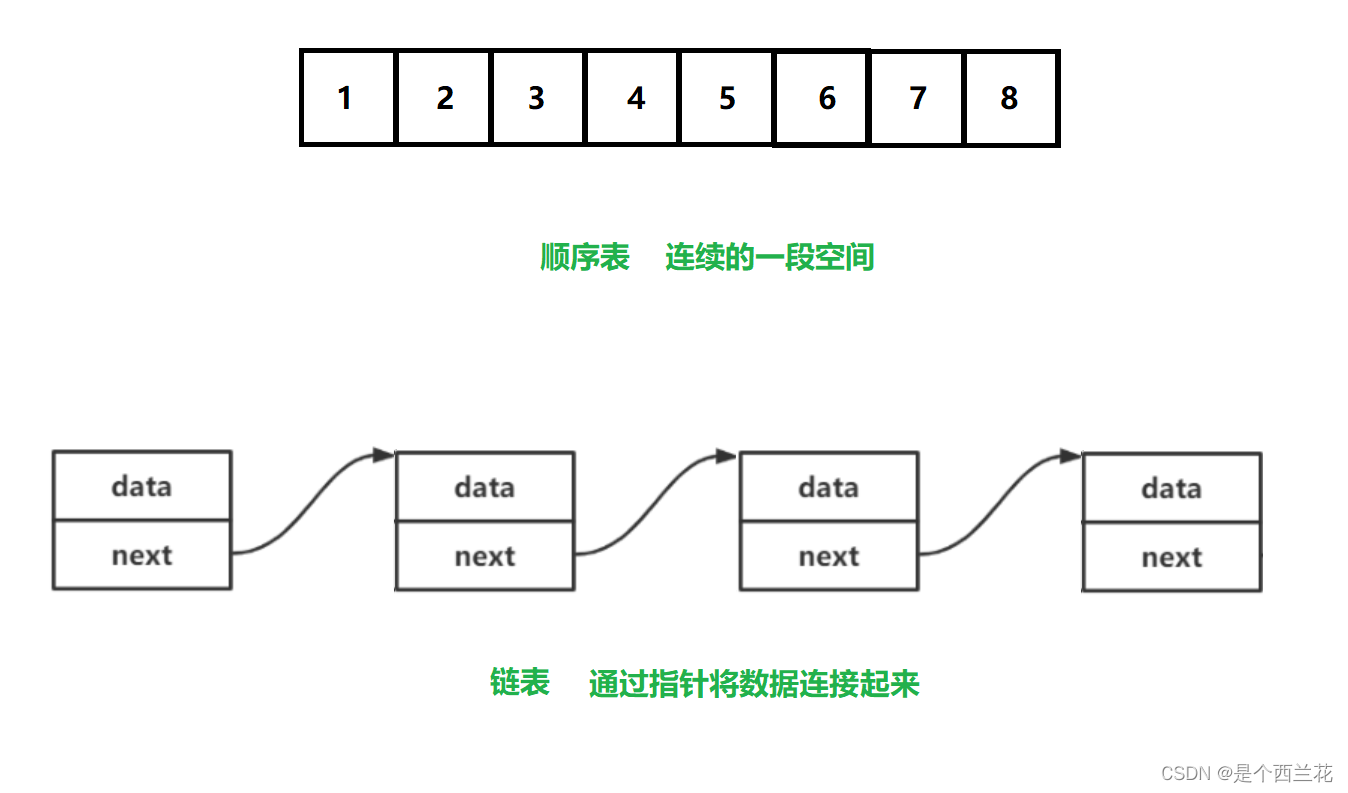目录
1.线性表
什么是线性表 :
线性表(linear list)是n个具有相同特性的数据元素的有限序列。线性表是一种在实际中广泛使用的数据结构,常见的线性表:顺序表、链表、栈、队列、字符串...,本篇文章介绍一下顺序表。
线性表在逻辑上是线性结构,也就说是连续的一条直线。但是在物理结构上并不一定是连续的,线性表在物理上存储时,通常以数组和链式结构的形式存储。
2.顺序表
2.1 概念和结构
顺序表是用一段连续的物理地址连续的存储单元依次存储数据元素,一般情况下采用数组存储。在数据上完成增删改查。
顺序表一般可以分为:
- 静态顺序表,使用定长数组存储元素。
- 动态顺序表:使用动态开辟的数组存储。
1.静态顺序表的定义
#define N 7 //顺序表的大小
typedef int SLDataType;
typedef struct SeqList
{
SLDataType array[N]; //定长数组,顺序表只能存储N个元素
int size; //有效元素个数
}SeqList;2.动态顺序表的定义
typedef int SLDatatype;
typedef struct SeqList
{
SLDatatype* a; //指向动态开辟的数组,空间不够可以扩容
int size; //有效数据个数
int capacity; //容量空间大小
}SeqList;2.2 接口实现
静态顺序表只适用于确定知道需要存多少数据的场景。静态顺序表的定长数组导致N定大了,空间开多了浪费,开少了不够用。
所以现实中基本都是使用动态顺序表,根据需要动态的分配空间大小,所以下面我们实现动态顺序表。
头文件 :
typedef int SLDatatype;
typedef struct SeqList
{
SLDatatype* a;
int size;
int capacity;
}SeqList;
//初始化
void SeqListInit(SeqList* ps);
//释放
void SeqListDestroy(SeqList* ps);
//打印
void SeListPrint(SeqList* ps);
//头插法
void SLPushfront(SeqList* ps, SLDatatype x);
//尾插法
void SLPushback(SeqList* ps, SLDatatype x);
//头删
void SLPopfront(SeqList* ps);
//尾删
void SLPopback(SeqList* ps);
//顺序表查找
int SeqListFind(SeqList* ps, SLDatatype x);
//在顺序表pos位置插入x
void SeqListInsert(SeqList* ps,int pos, SLDatatype x);
//删除顺序表pos位置的值
void SeqListErase(SeqList* ps,int pos);
//修改顺序表pos位置的值
void SeqListMidefy(SeqList* ps, int pos, SLDatatype x);函数的实现:
//初始化
void SeqListInit(SeqList* ps)
{
assert(ps);
ps->a = (SLDatatype*)malloc(sizeof(SLDatatype) * 4);
if (ps->a == 0)
{
perror("malloc fail");
return;
}
ps->size = 0;
ps->capacity = 4;
}
//释放
void SeqListDestroy(SeqList* ps)
{
assert(ps);
ps->size = 0;
ps->capacity = 0;
free(ps->a);
ps->a = NULL;
}
//打印
void SeListPrint(SeqList* ps)
{
assert(ps);
for (int i = 0; i < ps->size; i++)
{
printf("%d ", ps->a[i]);
}
printf("\n");
}
//检查容量
int CheckCapacity(SeqList* ps)
{
assert(ps);
if (ps->size == ps->capacity)
{
SLDatatype* ptr = (SLDatatype*)realloc(ps->a, sizeof(SLDatatype) * ps->capacity * 2);
if (ptr == NULL)
{
perror("realloc fail");
return 0;
}
else
{
ps->a = ptr;
ps->capacity *= 2;
}
}
return 1;
}
//头插法
void SLPushfront(SeqList* ps, SLDatatype x)
{
assert(ps);
if (CheckCapacity(ps) == 0)
{
return;
}
int end = ps->size;
while (end > 0)
{
ps->a[end] = ps->a[end - 1];
end--;
}
ps->a[0] = x;
ps->size++;
}
//尾插法
void SLPushback(SeqList* ps, SLDatatype x)
{
assert(ps);
if (CheckCapacity(ps) == 0)
{
return;
}
ps->a[ps->size] = x;
ps->size++;
}
//头删
void SLPopfront(SeqList* ps)
{
assert(ps);
assert(ps->size > 0);
int start = 1;
while (start < ps->size)
{
ps->a[start - 1] = ps->a[start];
start++;
}
ps->size--;
}
//尾删
void SLPopback(SeqList* ps)
{
assert(ps);
assert(ps->size > 0);
ps->size--;
}
//顺序表查找
int SeqListFind(SeqList* ps, SLDatatype x)
{
assert(ps);
for (int i = 0; i < ps->size; i++)
{
if (ps->a[i] == x)
{
return i;
}
}
return -1;
}
//在顺序表pos位置插入x
void SeqListInsert(SeqList* ps, int pos, SLDatatype x)
{
assert(ps);
assert(pos >= 0 && pos <= ps->size);
if (CheckCapacity(ps) == 0)
{
return;
}
int end = ps->size;
while (end > pos)
{
ps->a[end] = ps->a[end - 1];
end--;
}
ps->a[pos] = x;
ps->size++;
}
//删除顺序表pos位置的值
void SeqListErase(SeqList* ps, int pos)
{
assert(ps);
assert(pos >= 0 && pos < ps->size);//已经包含 ps->size > 0
int start = pos + 1;
while (start < ps->size)
{
ps->a[start - 1] = ps->a[start];
start++;
}
ps->size--;
}
//修改顺序表pos位置的值
void SeqListMidefy(SeqList* ps, int pos, SLDatatype x)
{
assert(ps);
assert(pos >= 0 && pos < ps->size);//已经包含 ps->size > 0
ps->a[pos] = x;
}2.3 数组相关面试题
2.4 顺序表的问题及思考
问题:
1.中间/头部的插入删除,时间复杂度为O(N)
2.增容需要申请新空间,拷贝数据,释放旧空间。会有不小的消耗。
3.增容一般是呈2倍的增长,势必会有一定的空间浪费。例如当前容量为100,满了以后增容到200,我们再继续插入了5个数据,后面没有数据插入了,那么就浪费了95个数据空间。
思考:如何解决以上问题呢?可以通过看下一篇文章链表来解决。
本篇结束:
